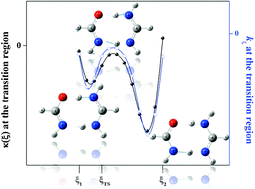Earlier work, both experimental and computational, has drawn attention to the transition region in a chemical reaction, which includes the traditional transition state but extends along the intrinsic reaction coordinate ξ from perturbed forms of the reactants to perturbed forms of the products. The boundaries of this region are defined by the reaction force F(ξ), which is the negative gradient of the potential energy V(ξ) of the system along ξ. The reaction force constant κ(ξ), the second derivative of V(ξ), is negative throughout the transition region. We have now demonstrated, for a series of twelve double
